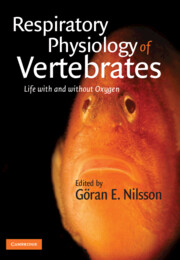4 - Oxygen uptake and transport in air breathers
Published online by Cambridge University Press: 05 June 2012
Summary
Introduction
Air-breathing vertebrates constitute a large group of diverse animals belonging to different taxonomic classes. Air breathing evolved independently in different groups of fish and early tetrapods, and extant species employ an array of different air-breathing organs that are derived from various existing structures, such as the gastrointestinal tract or the buccopharyngeal cavity (see Chapter 6). True lungs in terrestrial vertebrates develop embryologically as a ventral outpocketing of the posterior pharynx into a paired structure that extends into the peritoneal cavity. The entrance to the lung through the pharynx is guarded by the glottis, and the lungs are perfused by a pulmonary artery that carries oxygen-poor blood to the respiratory surfaces in the lungs, while a pulmonary vein returns oxygen-rich blood to the heart. Although the lungs of extant air-breathing vertebrates share a common embryological development and overall arrangement, there are large structural differences, from the simple sac-like lungs of amphibians to the complex structure of the alveolar lungs of mammals and the parabronchial lungs of birds. Regardless of the structural variation, in all air-breathing vertebrates the gas-exchange organs provide adequate exchange of O2 and CO2 to meet the variable metabolic needs of the animal.
Vertebrates supply the majority of their energetic requirements through aerobic metabolism. As the product of aerobic metabolism, adenosine triphospate (ATP), cannot be effectively stored, the oxygen-transport process represents a continual balance between delivery of oxygen (supply) and the use of ATP (demand).
- Type
- Chapter
- Information
- Respiratory Physiology of VertebratesLife With and Without Oxygen, pp. 95 - 128Publisher: Cambridge University PressPrint publication year: 2010



